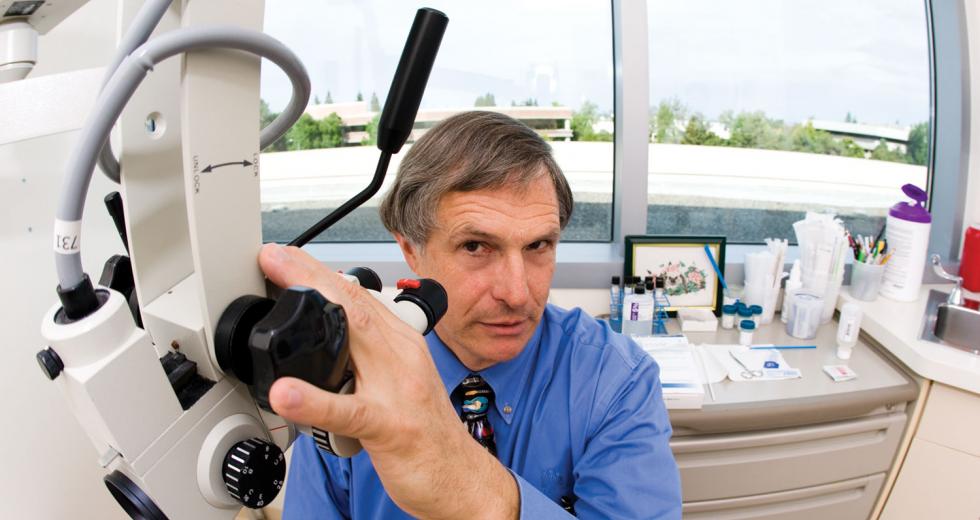Cervical cancer in the U.S. has been declining for the past 50 years, and with recent advancements in prevention and screening, doctors imagine the cancer could be eradicated from America’s population within your lifetime. It’s a lofty ambition with a major caveat: It is almost entirely dependent upon the participation of the nation’s underserved women.
“The way I see it, by using the evolving medical guidelines, the HPV vaccine, the new DNA testing and more HPV and cervical cancer awareness, I believe that cervical cancer cases will decrease significantly,” says Dr. Mary Miller, clinical medical director of obstetrics and gynecology for the UC Davis Health System. “I think within the next two decades we could see it gone.”
The past five years have ushered in the broad use of a test that, when used alongside a Pap smear, can detect more than 99 percent of cervical cancer cases. Coupled with the use of new vaccines, the nation’s youngest females now have some serious defenses against the disease. The problem, clinicians say, is that most cervical cancer occurs in women who don’t participate in prevention and screening: the poor and uneducated.
Cervical cancer is one of the few cancers largely caused by a virus — the human papillomavirus — and that virus is extremely common. Approximately 20 million Americans are currently infected, according to the Centers for Disease Control and Prevention, and another 6.2 million people become infected each year.
“Some people have said it’s the common cold of the genital tract,” says Dr. Debbie Saslow, director of breast and gynecologic cancer for the American Cancer Society. “Estimates are that 50 to 80 percent of people who have ever been sexually active have had an HPV virus. … Occasionally, those virus types can cause changes in the cervix, and if they are not treated, they can progress to cancer.”
“I think within the next two decades we could see [cervical cancer] gone.”
Dr. Mary Miller, clinical medical director of obstetrics and gynecology, UC Davis Health System
There are more than 100 strains of HPV, including about 40 that affect mucosal surfaces such as those found in the mouth, cervix, vagina and rectum. Of those 40, about 15 are capable of causing cancer. In the U.S., cervical cancer occurs annually in roughly 8.5 women per 100,000. As a result, the American Cancer Society estimates 11,270 cases of invasive cervical cancer will be diagnosed this year, resulting in more than 4,070 deaths.
Testing cervical cells is an effective way to identify high-risk HPV strains.
The Food and Drug Administration has approved an HPV DNA test for women over 30 for general cervical cancer screening or for follow-up after an ambiguous Pap test result. This test, which is highly favored by doctors, can identify at least 13 of the high-risk types of HPV associated with the development of cervical cancer. The test, which looks for viral DNA, uses molecular technology to detect the presence of high-risk types of HPV even before there are any visible or conclusive changes to cervical cells.
There are currently no approved tests to detect HPV infection in men. Most men who get HPV never develop symptoms or health problems. However, the virus is responsible for genital warts in 1 percent of the population and can also cause penile and anal cancers.
“The biggest problem is that people don’t agree to participate in screening,” says Kaiser gynecological oncologist Dr. Walter Kinney. “About 60 percent of our cancers are in women who haven’t been screened in the past three years. “The other half are the result of failures during testing or a failure to follow up.”
But even 11,270 cases of cervical cancer is a fraction compared to rates in previous decades.
“If you go back 60 years, you would see a huge drop in cervical cancer cases and deaths — about 75 percent — once we introduced the Pap smear,” Saslow says. “In the couple of decades to follow, as more and more women were getting the test, we saw rates go down probably more rapidly than any other cancer.”
The Pap smear, named for George Papanicolaou, was created in the early 20th century as a way to detect abnormal cell activity in the cervix. Papanicolaou observed that the cervix constantly shed cells, and by collecting those cells, precancerous and cancerous cells can be identified.
“Estimates are that 50 to 80 percent of people who are sexually active have had an HPV virus.”
Dr. Debbie Saslow, director of breast and gynecologic cancer, American Cancer Society
HPV causes the majority of cervical cancers, but it doesn’t do this overnight. It takes about 15 years, on average, for the cells to mutate enough to cause problems. Because of that timeline, cervical cancer is exceedingly rare in women under the age of 30. Treatment usually involves the removal of abnormal cells via freezing, laser ablation or surgical knife.
The problem with the Pap smear, according to Kinney, is the test lacks specificity and sensitivity and only identifies 34 to 75 percent of the precancerous situations.
“And golly, that’s not very good,” Kinney says. “That means if you’re going to do Pap smears, you have to do them every year. But then you find a whole lot of people with irregular Paps who have nothing wrong with them but who have to come in for biopsies. And then you end up cutting off pieces of the cervix. How rude! You don’t want to put people through treatments that they don’t need.”
In 2003, the FDA approved the HPV DNA test for general population screening, partly as a result of the research provided by Kinney. Since then it has grown rapidly in popularity, and today only about 6 percent of Kaiser’s eligible patients choose the option of annual Pap smear alone.
“A Pap and HPV test together pick up more than 99 percent of cervical cancers. It’s like keeping your pants on with a belt and suspenders,” Kinney says. “The HPV test is much more sensitive for precancer.”
The Pap smear retains its value because it provides reassurance that the HPV test is not somehow wrong. There are also women who have cancer of the lining of the uterus, the endometrium. Those cases might not occur in HPV-positive women, but the Pap smear still detects the cellular irregularities. About one in five women with endometrial cancer will have an abnormal Pap smear.
If a patient tests negative for HPV, she has almost no risk of getting cancer in the near future. If a woman has a positive HPV test a negative pap smear and is over the age of 30, she should return for follow-up in a year. If she tests positive again, she should have a work-up, Kinney says.
“A Pap and HPV test together pick up more than 99 percent of cervical cancers. It’s like keeping your pants on with a belt and suspenders.”
Dr. Walter Kinney, gynecological oncologist, Kaiser
“When we came out with guidelines and the FDA approved the test six years ago, the biggest concern was that this test would be used too often,” Saslow says. “If both tests are negative, she doesn’t need a test for another three years, and even that is conservative. The papers coming out now are saying at least six years.”
Moving away from annual screenings means big change. For many women, it has become a decades-long habit.
“Five and 10 years ago, and still going on in the backwoods, you will see 14 year olds being treated for abnormal Paps, and that is not a good thing for young women,” Kinney says.
Based on the studies coming out of Europe and Canada, doctors are starting to question just how long a woman is safe between screenings. Fewer screenings mean lower medical costs and fewer unnecessary procedures.
And then there is the vaccine. Gardasil, manufactured by Merck & Co. Inc., is the new cervical cancer vaccine recommended for females ages 9 to 26. It is administered in a series of three shots and protects against four strains of HPV.
“It is going to be most effective if a girl gets the shots before she is sexually active,” Saslow says. “Then when she gets to be screening age, she isn’t going to need as much screening because she is protected from the [strains] that cause 75 percent of cancer.”
The clinical studies of the vaccine are now about seven years old and are being watched in countries with sophisticated registry systems such as Scandinavia, where most women opted to have their daughters vaccinated and every Pap smear is documented.
“I would say that within the next decade we are going to see a decrease in precancer, but there are still a lot of issues early on. For one thing, we don’t have great records on how many girls got all three shots,” Saslow says. “There are studies looking at the benefits of just getting two shots, but we don’t have the answer yet. One shot probably won’t do it.”
Currently, 25 percent of 13- to 17-year-olds are getting the Gardasil shots, a relatively successful rate for a new vaccine. Doctors presume the rate won’t get much higher unless the vaccine is required in public schools, but that argument has opened a wider debate with Conservatives, who oppose the vaccine for morality reasons.
There are more than 100 strains of HPV, including about 40 that affect mucosal surfaces. … Of those 40, about 15 are capable of causing cancer.
But a bill in Washington D.C. — the Human Papillomavirus Vaccination and Reporting Act of 2007 — went into effect this fall and requires female students in the sixth grade who are enrolling for the first time in a public, charter, private or parochial school in the district to be vaccinated before they can attend classes. Four states have also mandated the vaccine for girls.
The D.C. mandate will be enforced by the Department of Health, but parents have the right to opt out. Parents can refuse to have their daughters vaccinated based on religious reasons, if the child’s physician submits a written statement that indicates that the vaccine is inadvisable or if parents themselves submit the HPV Vaccine Refusal Certificate.
Many in the medical community see the move as a small victory toward eliminating cervical cancer.
“It won’t go away if people don’t get their vaccines and participate in screening,” Kinney says. “But for those who are participating, we can get the rate down to single digits per million per year.”
Could HPV go the way of the dodo?
In 2006, global pharmaceutical developer Merck & Co. Inc. introduced Gardasil to the U.S. market. The vaccine, which is administered via three injections over six months, protects girls and young women against the four types of genital human papillomavirus that cause most cases of cervical cancer and genital warts.
So far, the drug has been relatively successful, as nearly 25 percent of its target population has stepped forward to receive the vaccine.
Now, a new drug is ready to compete.
GlaxoSmithKline’s Cervarix has been approved for use in more than 90 countries around the world, including the 27 member countries of the European Union, Mexico, Australia, Singapore and the Philippines. It is still awaiting FDA approval in the United States, but based on favorable recommendations by FDA committees, would likely be approved in the coming months.
Gardasil is routinely recommended for 11- and 12-year-old girls and for girls and women age 13 through 26 who have not yet been vaccinated or completed the vaccine series. Glaxo is pitching its vaccine for use for adolescents and women up to age 45.
The vaccines are designed differently. Gardasil targets four HPV types including those that cause most cases of genital warts, while Cervarix targets two types and isn’t intended to provide as much protection against warts.
“From a cervical cancer perspective, overall both vaccines work really great. In the UK, the national health care system uses Cervarix only,” says Dr. Debbie Saslow, director of breast and gynecologic cancer at the American Cancer Society.
Merck, meanwhile, has been successful in garnering approval by the FDA to release Gardasil for use in males as a way to prevent genital warts, which are also caused by HPV. Each year, about 200 out of 100,000 males are newly diagnosed with genital warts, according to the FDA.
Studies of more than 5,000 boys and men found Gardasil was 89 percent effective at preventing genital warts, which affect an estimated 1 million American men and women.
In early September, an FDA advisory committee voted to recommend approval of Gardasil for males ages 9 to 26.
According to gynecological oncologist Dr. Walter Kinney, a â?¨Kaiser Permanente doctor heavily involved with the research and development of cervical cancer tests and treatments, if 50 percent of each gender in America’s youngest generations are vaccinated against HPV, the virus and it’s consequential diseases could be eradicated.
Recommended For You

Head-Turning Technology
Advanced treatment promises better outcomes for prostate cancer
Rollie Swingle didn’t have treatment options for his stage IV prostate cancer.

Death by Desk Chair
How to combat our national sitting epidemic
Those long hours you’re logging at your desk may be taking a physiological toll that your morning run and bike commute can’t quite undo. We’re in the midst of a sitting epidemic that comes with some pretty scary health implications, but a simple change in our corporate culture might hold the key to better fitness for us all.




